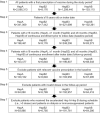Hepatitis vaccination adherence and completion rates and factors associated with low compliance: A claims-based analysis of U.S. adults
- PMID: 35176102
- PMCID: PMC8853527
- DOI: 10.1371/journal.pone.0264062
Hepatitis vaccination adherence and completion rates and factors associated with low compliance: A claims-based analysis of U.S. adults
Abstract
Poor compliance with multi-dose vaccine schedules by adults for whom hepatitis (Hep) A and B vaccines are recommended contributes to major Hep A and B disease burdens among high-risk U.S. adults. Evidence on hepatitis vaccine series adherence, completion, timeliness of completion, and factors associated with these outcomes, is limited and not readily generalizable for U.S. adults. This retrospective, observational study examined adherence, completion, its timeliness, and the impact of sociodemographic and clinical factors on these outcomes among a large, geographically representative sample of U.S. adults. We analyzed the Optum Clinformatics SES administrative claims database (1/1/2010-6/30/2020) for recipients of 2-dose (HepA, HepB2) or 3-dose (HepB3, HepAB) hepatitis vaccines. Adherence was defined as receipt of booster doses within specified assessment periods, per label-recommended schedules. Completion (receipt of all doses) was assessed at 6, 12, 18, and 24 months.The study included 356,828 adults ≥19 years old who were continuously enrolled in a medical benefit plan for one (HepB2), six (HepB3; HepAB), or 18 months (HepA) prior to and following the index date (first observed vaccine dose). Adherence and 24-month completion rates were: HepA (27.0%, 28.4%), HepB2 (32.2%, 44.8%), HepB3 (14.3%, 37.3%), HepAB, (15.3%, 33.8%). Kaplan-Meier completion curves plateaued after about 6 months for HepB2 and about 12 months for HepA, HepB3, and HepAB vaccines. Logistic regression analyses showed risk for low adherence/completion was generally associated with male gender, younger age, Black or Hispanic race/ethnicity, lower educational or household income attainment, and more comorbidities. Adherence and completion rates for all hepatitis vaccine series are low, especially for males, younger adults, those with lower socio-economic status and more comorbidities. To our knowledge, this is the largest claims-based analysis of adherence and completion rates for U.S. adults initiating all currently available HepA and HepB vaccines. Findings may inform hepatitis vaccination programming.
Conflict of interest statement
This study was funded by Janssen Scientific Affairs, LLC. J.L., X.F., C.D.P., M. M-F., and O.S. were employees of Janssen Scientific Affairs, LLC (a Johnson & Johnson company) while designing and conducting this study. J.L., X.F., C.D.P., M. M-F. and O.S. also hold stock in Johnson & Johnson. This does not alter our adherence to PLOS ONE policies on sharing data and materials. A.K. reports no conflicts of interest.
Figures



References
-
- WHO. Global Hepatitis Report 2017 [10 June 2021]. Available from: https://www.who.int/publications/i/item/global-hepatitis-report-2017
-
- WHO. Global progress report on HIV, viral hepatitis and sexually transmitted infections, 2021 2021. [10 June 2021]. Available from: https://www.who.int/publications/i/item/9789240027077;2021
-
- Centers for Disease Control and Prevention. Recommended Adult Immunization Schedule for ages 19 years or older, United States 2021 [19 April 2021]. Available from: https://www.cdc.gov/vaccines/schedules/hcp/imz/adult-compliant.html;2021 - PubMed
-
- Centers for Disease Control and Prevention. Viral Hepatitis Surveillance Report 2021 [10 June 2021]. Available from: https://www.cdc.gov/hepatitis/statistics/SurveillanceRpts.htm
Publication types
MeSH terms
Substances
LinkOut - more resources
Full Text Sources
Medical

